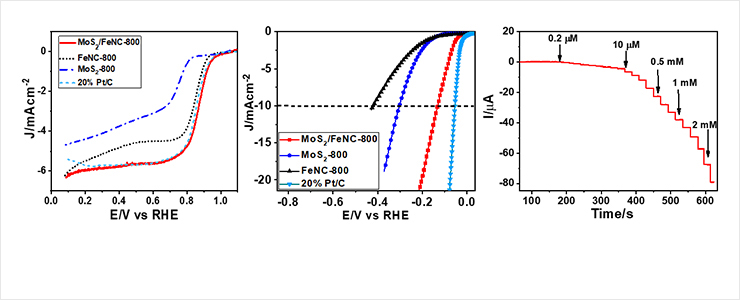Representative Research Publications
All-in-One Electrocatalyst for Fuel Cells, Hydrogen Generation, and Disease Detection 2025 > Representative Research Publications > Research Results Home
All-in-One Electrocatalyst for Fuel Cells, Hydrogen Generation, and Disease Detection
- J. Mater. Chem. A / 2025. 4.
- Jannath KA, Kyubin Shim, Kyeong-Deok Seo (First author), Hae Jin Kim, Deog-Su Park (Corresponding author)
Research Summary
A team of Korean researchers has successfully developed a novel multifunctional electrocatalyst that enables hydrogen production (HER), oxygen reduction (ORR), and ultrasensitive detection of hydrogen peroxide(H₂O₂) all with a single material platform. This catalyst is composed of molybdenum disulfide(MoS₂) nanosheets anchored onto iron and nitrogen co-doped carbon nanospheres(FeNC). Through controlled synthesis involving polymer coordination and thermal treatment, a unique Mo–N/Fe–N interface was engineered, which enhances both electronic conductivity and reaction kinetics. In performance evaluations, the MoS₂/FeNC-800 catalyst demonstrated:
Related Figures
 Fig. 1 Fe–polydiaminonaphthalene (Fe-pDAN) is synthesized via coordination of 1,8-DAN and FeCl₃, followed by pyrolysis to obtain FeNC. MoS₂ nanosheets are grown on FeNC via hydrothermal reaction and further pyrolyzed to form the final multifunctional catalyst, MoS₂/FeNC-800.
Fig. 1 Fe–polydiaminonaphthalene (Fe-pDAN) is synthesized via coordination of 1,8-DAN and FeCl₃, followed by pyrolysis to obtain FeNC. MoS₂ nanosheets are grown on FeNC via hydrothermal reaction and further pyrolyzed to form the final multifunctional catalyst, MoS₂/FeNC-800.
- ● Superior ORR activity with a half-wave potential (E₁/₂) of 0.866 V, exceeding that of commercial 20% Pt/C catalysts
- ● Outstanding HER activity with a low overpotential of 128 mV at 10 mA cm⁻² in alkaline media
- ● Excellent durability and methanol tolerance, making it suitable for practical fuel cell applications
Moreover, the catalyst displayed remarkable sensitivity in H₂O₂ detection, with a detection limit as low as 200 nM, allowing real-time monitoring of H₂O₂ released from both normal and cancerous cells. This points to its strong potential in biosensing and clinical diagnostics, especially for detecting oxidative stress and early-stage diseases such as cancer.
 Fig. 2 (Left) ORR activity, (Middle) HER performance compared to control and Pt/C, (Right) Amperometric response showing sensitive H₂O₂ detection down to 0.2 μM.
Fig. 2 (Left) ORR activity, (Middle) HER performance compared to control and Pt/C, (Right) Amperometric response showing sensitive H₂O₂ detection down to 0.2 μM.
The multifunctional capabilities of this catalyst achieved through a synergistic combination of phase engineering, heteroatom doping, and interfacial charge modulation highlight its promise as a next-generation material for sustainable energy conversion and biomedical sensing. The results were published in the Journal of Materials Chemistry A (2025), emphasizing the feasibility of scalable, low-cost alternatives to precious metal catalysts like platinum.



